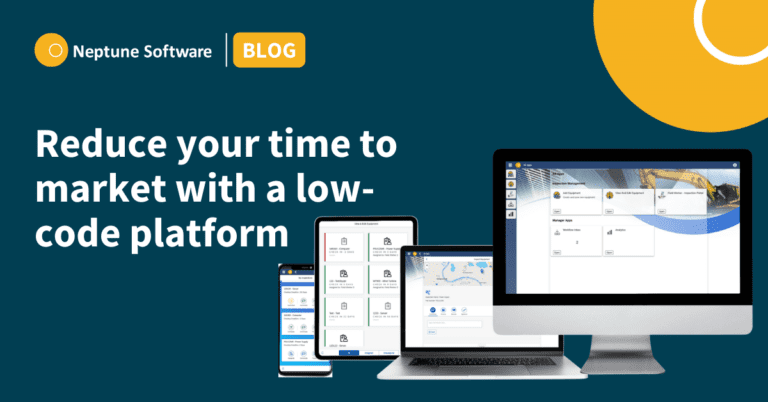From analog to mobile maintenance - 5 reasons that support the low code approach.

Introduction - Five reasons why the low code approach can drive mobile maintenance
Imagine entire plants and machinery being maintained 100% on the move and without any paper at all. This idea is not a wish for the future but rather a necessity. The industry needs to lead the way and digitize everywhere to eliminate media breaks in maintenance and ensure smooth and efficient production with as little downtime as possible. So, mobilizing maintenance is essential for business success. It brings countless benefits when implemented based on modern technologies: digitization of maintenance processing and documentation, flexibility with end devices and locations without network coverage (offline), and the reduction of downtime.
Take, for example, a mid-sized company that uses SAP PM processes. With targeted mobile applications, SAP processes can be digitized quickly and cost-effectively, eliminating time-consuming steps and, most importantly, paper. The entire maintenance process is thus integrated into the IT landscape. The maintenance engineer can now create error messages at the point of use (online and offline), quickly identify equipment, and enrich it with historical information. New technologies can also be envisioned, such as using data glasses or AR (augmented reality), which allow a technician to work more efficiently with both hands thanks to voice recognition software.
If a digitization process has been initiated here and there, it is still not happening fast and consistently. The reasons: existing challenges – cost pressure, increasing competition – and the pandemic’s impending effects weigh heavily on the shoulders of the manufacturing industry.
The low code approach offers the right solution for IT and the business unit alike. On the one hand, it relieves both departments, and on the other, it takes a step forward in digitization. According to the latest Gartner statement, demand is growing rapidly due to the “interplay of digital disruption, hyper-automation and the rise of composable business”. In other words, rapid application development (RAD) vendors are enabling companies to put together their own desktop or mobile applications with little to no programming knowledge quickly. Here, we’ll take a closer look at five reasons why the low code approach can drive mobile maintenance:
1. Low code development platforms promote cross-functional project management
Medium-sized companies are familiar with this: employees from different departments need new products, tools or platforms and go to IT with their requests. But even with the right programming skills, developers can’t keep up with the demand. Depending on the requirements, existing skills and schedule, companies need help with mobilization. However, companies usually already have all the skills and data they need. RAD platforms can then provide the right tool mix between in-house development, template apps and ready-made solutions. But that alone is still not enough. For the most efficient business processes to emerge, close collaboration between business departments and IT teams is needed.
A low code approach can help close the gap and bring IT and business together. Low code requires less programming skills and makes complex infrastructures tangible for all employees, including template apps. Business developers – subject matter experts from the business level – can now be part of the development process, giving IT staff a better understanding of business needs. The business developer uses their experience to design the app’s framework, while IT teams can still access the code to improve it.
In general, the role of IT is changing dramatically. From the business side’s operational arm, developers or IT managers are now much more involved in strategic decisions and lead the digitization process.
2. Free choice of devices and operating systems
Mobile devices and applications are ubiquitous in our everyday lives – so why not use them for maintenance as well? Performing such elaborate processes with pen and paper is outdated and highly prone to error. We say it’s time to move them to an app on a smartphone or tablet. Then comes the next question: which devices or operating systems should we develop these apps? Many still find it challenging to develop for iOS, Android and Windows in parallel. But it doesn’t have to be.
The hybrid low code approach is a big plus because it allows a free choice in end devices. Applications are developed once and can then be packaged and deployed for all operating systems. Native device functions such as barcode scanners and cameras can also be easily integrated into the applications.
When it comes to web or native applications, the trend is clearly toward web applications. The Covid-19 crisis has shown us all how important location/independent working has become. Users want to use their applications from anywhere and on any device. With native software, this can only be implemented with extremely high effort. In contrast, web applications are accessed via URL when they are deployed. With a development platform such as the Neptune DX Platform, such applications can be quickly converted into a progressive web application and immediately installed directly on all end devices. This also eliminates the need to “manually” call a URL. The best thing about this is updates are automatically pulled from the server – every time the user opens the app, it is up to date.
3. Low time and cost expenditure
In the mobilization of maintenance, as everywhere, time is money. A low code platform shortens the development time of functional apps from several months to a few weeks. The platform builds on the existing infrastructure and extends it allowing applications to be piloted with little effort and quickly. Initial prototypes are tested, evaluated and improved after just a few weeks.
Due to cost pressure in all industries, increasing maintenance requests and user numbers, companies are increasingly looking for affordable, easy-to-use and flexible applications. For example, Vattenfall improved information exchange with workers in the field, streamlined SAP processes and reduced maintenance and repair costs by introducing mobile applications for order and message management, checklists and maintenance instructions. In practice, the first applications were tested in two wind farms after just a few weeks and later implemented across all their sites thanks to user feedback.
4. Online and Offline usability
Another argument in favor of the low code approach is the provision of all current and relevant order data, whether online or offline. This feature is essential to avoid media discontinuity, for example, for employees working on-site at large machine plants or offshore locations. In this case, they need to access data and provide feedback on maintenance operations even without a connection.
For maintenance workers to access data offline and synchronize it with their information, a digital ecosystem characterized by an open information chain is needed. The advantage of this hybrid online-offline infrastructure is to support transparency, avoid duplication of effort, and most importantly, errors. Using this approach, many companies have been able to speed up their entire maintenance process and increase user satisfaction.
5. Individual apps for each usage scenario
The previous two points bring us to the final argument of how low code supports the mobilization of maintenance. These apps build on various internal software and tools already available to unify them into one app. But creating a single app to mobilize an entire process tends to be counterproductive. Splitting processes into multiple apps allows companies to focus on each process and develop apps that are truly needed. This is what we call the Launchpad idea: this is how lean apps are developed for sub-processes that call on each other and pass data. In this way, a feedback process can be mapped on the maintenance order. In addition, individual apps can be provided for different user groups. Whether for capturing photos and measured values, status changes, feedback, service reports, forms and checklists, material logistics – these apps can be easily extracted and reused for other scenarios.
Conclusion
The step from analog to mobile maintenance is important and necessary for a wide variety of industries. Not only to digitize processes internally and bring teams closer to the current age but to remain competitive. It’s the only way medium-sized companies will be able to stay ahead in their markets and internationally in the years ahead. Success stories such as Infraserv Höchst, Hauni, Würzburger Versorgung und Verkehr GmbH and Vattenfall are also proof that mobile maintenance can be easily synchronized with the overall digitization strategy. In the case of Infraserv Höchst, Neptune Software has enabled the industrial park in Frankfurt am Main to reduce development effort by 70% through 22 applications on all major operating systems, cut setup effort by 80%, and reduce maintenance and inspection chain cycle time by another 40%. This has also led the company to introduce new technologies such as digital data glasses, which to date are the world’s first complete SAP-integrated solution.
Want to know more about how the low code approach can help drive your company from having analog to mobile maintenance processes? Get in touch!
About the author


Christoph Garms
Managing Director Neptune Software Germany
For Christoph, the key to successful digital change lies in the right technical tools. His vision as Managing Director of Neptune Software in Germany is to bridge the gap between business and IT and to move the DACH market towards a true digital transformation. With his cross-industry expertise, Christoph is certain that this is a question of digitalizing from process to process, creating a new work culture with agile methods and cross-functional teams. As a graduate software architect and with extensive background in pre-sales for Neptune Software, he knows the importance to supporting partners and customers from the first demo to implementation, onboarding and expert training.
Yes we eat cookies on Planet Neptune!
To provide you with the best browsing experience, personalized content and targeted ads, we are using cookies to collect that information. We hope you're ok with it. By clicking "I agree" you accept our cookies. Feel free to refer to our cookie policy for a description. I agree SettingsPrivacy Overview
| Cookie | Duration | Description |
|---|---|---|
| bcookie | 2 years | This cookie is set by linkedIn. The purpose of the cookie is to enable LinkedIn functionalities on the page. |
| lang | session | This cookie is used to store the language preferences of a user to serve up content in that stored language the next time user visit the website. |
| lidc | 1 day | This cookie is set by LinkedIn and used for routing. |
| Cookie | Duration | Description |
|---|---|---|
| _gat | 1 minute | This cookies is installed by Google Universal Analytics to throttle the request rate to limit the colllection of data on high traffic sites. |
| YSC | session | This cookies is set by Youtube and is used to track the views of embedded videos. |
| Cookie | Duration | Description |
|---|---|---|
| _ga | 2 years | This cookie is installed by Google Analytics. The cookie is used to calculate visitor, session, campaign data and keep track of site usage for the site's analytics report. The cookies store information anonymously and assign a randomly generated number to identify unique visitors. |
| _gat_gtag_UA_28799357_1 | 1 minute | This cookie is set by Google and is used to distinguish users. |
| _gat_UA-28799357-1 | 1 minute | This is a pattern type cookie set by Google Analytics, where the pattern element on the name contains the unique identity number of the account or website it relates to. It appears to be a variation of the _gat cookie which is used to limit the amount of data recorded by Google on high traffic volume websites. |
| _gid | 1 day | This cookie is installed by Google Analytics. The cookie is used to store information of how visitors use a website and helps in creating an analytics report of how the website is doing. The data collected including the number visitors, the source where they have come from, and the pages visted in an anonymous form. |
| Cookie | Duration | Description |
|---|---|---|
| _fbp | 3 months | This cookie is set by Facebook to deliver advertisement when they are on Facebook or a digital platform powered by Facebook advertising after visiting this website. |
| bscookie | 2 years | This cookie is a browser ID cookie set by Linked share Buttons and ad tags. |
| fr | 3 months | The cookie is set by Facebook to show relevant advertisments to the users and measure and improve the advertisements. The cookie also tracks the behavior of the user across the web on sites that have Facebook pixel or Facebook social plugin. |
| IDE | 1 year 24 days | Used by Google DoubleClick and stores information about how the user uses the website and any other advertisement before visiting the website. This is used to present users with ads that are relevant to them according to the user profile. |
| test_cookie | 15 minutes | This cookie is set by doubleclick.net. The purpose of the cookie is to determine if the user's browser supports cookies. |
| UserMatchHistory | 1 month | Linkedin - Used to track visitors on multiple websites, in order to present relevant advertisement based on the visitor's preferences. |
| VISITOR_INFO1_LIVE | 5 months 27 days | This cookie is set by Youtube. Used to track the information of the embedded YouTube videos on a website. |
| Cookie | Duration | Description |
|---|---|---|
| AnalyticsSyncHistory | 1 month | No description |
| CONSENT | 16 years 7 months 13 hours | No description |
| cookielawinfo-checkbox-functional | 1 year | The cookie is set by GDPR cookie consent to record the user consent for the cookies in the category "Functional". |
| cookielawinfo-checkbox-others | 1 year | No description |
| li_gc | 2 years | No description |
| wp23527 | 1 year | No description |







